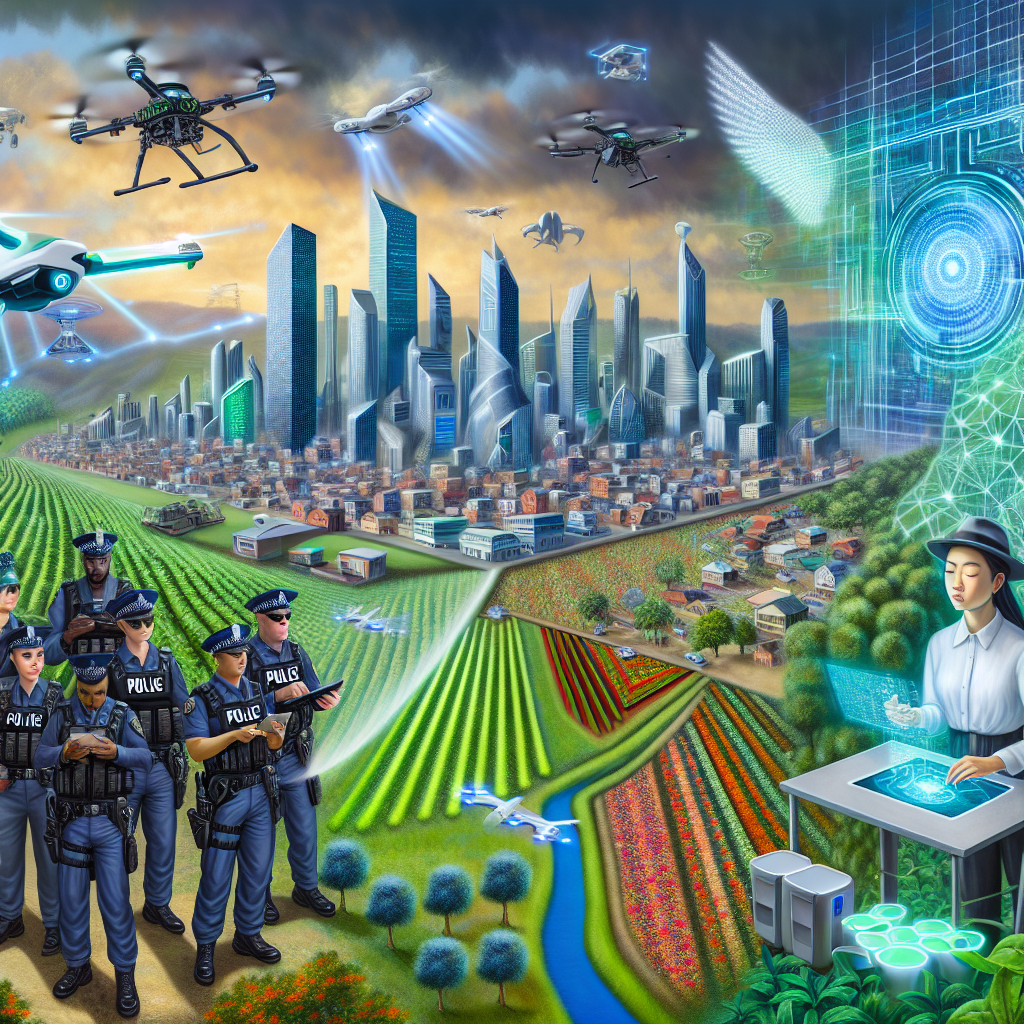The Impact of AI Technology in Policing and Agriculture
Introduction
Artificial Intelligence (AI) has emerged as a pivotal force across various sectors, transforming the way we interact with technology and each other. AI involves the use of computer systems to perform tasks that typically require human intelligence, such as decision-making, problem-solving, and data analysis. In recent years, AI’s penetration into fields like policing and agriculture has shown significant potential to enhance efficiency, resource management, and public safety. This blog post explores how AI is revolutionizing both policing and agriculture while addressing ethical considerations and future implications.
Application in Policing
AI technologies have found myriad applications in law enforcement, aiding in the prediction and prevention of crime. Predictive policing tools utilize algorithms to analyze crime data, identifying patterns that can help police allocate resources more effectively. Moreover, the use of facial recognition technology assists in identifying and tracking suspects, making operations more efficient.
Several case studies highlight the effectiveness of AI in reducing crime rates and optimizing resource allocation. For example, predictive policing has been successfully implemented in cities like Los Angeles and Chicago, where it has reportedly contributed to significant reductions in property crimes. Yet, despite these benefits, the use of AI in policing raises concerns about potential bias and ethical issues. Facial recognition, in particular, has faced criticism for its propensity to misidentify individuals, especially among minority groups.
Community responses to AI in law enforcement vary. While some communities appreciate the increased safety and efficiency, others express concern over privacy invasion and discrimination. It is crucial for law enforcement agencies to engage with communities, ensuring transparency and accountability in the use of AI technologies.
Application in Agriculture
In the agricultural sector, AI is ushering in a new era of precision farming, enhancing the efficiency and productivity of agricultural practices. AI applications like precision agriculture leverage data analytics to monitor crops and optimize planting patterns. Machine learning algorithms contribute to yield forecasting and pest management, improving both the quality and quantity of crops produced. Technologies such as drones and autonomous vehicles are revolutionizing crop management, providing real-time data for better decision-making.
A tangible example of AI’s influence is in crop disease detection, where AI models identify early signs of plant diseases, thereby enabling timely interventions. This not only boosts crop health but also reduces the use of crop protectants, aiding in sustainable farming practices. The benefits of AI in agriculture extend to resource management, where precision techniques optimize the use of water, fertilizers, and other inputs, minimizing waste and environmental impact.
Despite these advances, challenges remain in implementing AI technologies in agriculture, particularly in terms of technology costs and the necessity for farmer training. As AI-driven methods require initial investment in technology and infrastructure, they can be cost-prohibitive for small-scale farmers. Training is essential to bridge the gap between traditional practices and modern techniques, ensuring that farmers can fully leverage AI tools.
Future Trends
Looking ahead, AI in policing and agriculture is poised to evolve significantly over the next 5-10 years. In policing, advancements in AI and machine learning could enhance the sophistication of predictive models, improving accuracy and reducing bias. The integration of AI with other emerging technologies like the Internet of Things (IoT) and blockchain may further bolster law enforcement capabilities.
Similarly, in agriculture, the fusion of AI with IoT devices is expected to offer more granular insights into crop health and environmental conditions, enabling smarter farming decisions. Investments and breakthroughs in AI-related technologies continue to grow, with potential benefits extending to improved food security and resource sustainability.
Ethical Considerations
The ethical concerns of AI usage cannot be overlooked, especially in sensitive areas like policing. Issues around privacy, discrimination, and data security remain critical challenges that demand attention. The deployment of AI in law enforcement must prioritize fairness and transparency to avoid reinforcing existing biases. In agriculture, ethical implications include impacts on biodiversity and food security, emphasizing the need for responsible AI use that supports sustainability.
Establishing guidelines and regulations for AI development and deployment is essential to mitigate potential ethical pitfalls. By fostering a culture of responsible innovation, stakeholders can ensure that AI technologies contribute positively to society.
Conclusion
AI’s transformative potential in both policing and agriculture is undeniable. From enhancing crime prevention to optimizing farming practices, AI provides substantial societal benefits. However, the parallel need to address ethical concerns remains paramount. Embracing AI responsibly will require collaboration between policymakers, technologists, and communities to foster innovations that uphold ethical standards and societal well-being. As we continue to harness the power of AI, it is crucial for stakeholders to engage proactively in shaping a future where technology serves humanity equitably.
Sources & Links
- BasicAI’s Blog on AI in Agriculture
- CyberDB on IT Security Compliance
- Pew Research on Gene Editing
- GreenTek Solutions on Technology Impact
- CRN on Tech M&A Deals
?> Python Code Example
As an illustration of AI’s application in agriculture, consider a simple convolutional neural network (CNN) model built with TensorFlow and Keras to detect crop diseases.
import numpy as np
import tensorflow as tf
from tensorflow.keras.models import Sequential
from tensorflow.keras.layers import Conv2D, MaxPooling2D, Flatten, Dense, Dropout
from tensorflow.keras.preprocessing.image import ImageDataGenerator
# Define constants
IMG_WIDTH, IMG_HEIGHT = 150, 150
BATCH_SIZE = 32
EPOCHS = 10
NUM_CLASSES = 3 # Example: Healthy, Bacterial Leaf Blight, Brown Spot
# Create a simple CNN model for crop disease detection
def create_model():
model = Sequential([
Conv2D(32, (3, 3), activation='relu', input_shape=(IMG_WIDTH, IMG_HEIGHT, 3)),
MaxPooling2D(pool_size=(2, 2)),
Conv2D(64, (3, 3), activation='relu'),
MaxPooling2D(pool_size=(2, 2)),
Conv2D(128, (3, 3), activation='relu'),
MaxPooling2D(pool_size=(2, 2)),
Flatten(),
Dense(512, activation='relu'),
Dropout(0.5),
Dense(NUM_CLASSES, activation='softmax')
])
model.compile(optimizer='adam', loss='categorical_crossentropy', metrics=['accuracy'])
return model
# Data augmentation
def create_data_generators():
train_datagen = ImageDataGenerator(
rescale=1./255,
rotation_range=20,
width_shift_range=0.2,
height_shift_range=0.2,
shear_range=0.2,
zoom_range=0.2,
horizontal_flip=True,
fill_mode='nearest'
)
validation_datagen = ImageDataGenerator(rescale=1./255)
train_generator = train_datagen.flow_from_directory(
'dataset/train',
target_size=(IMG_WIDTH, IMG_HEIGHT),
batch_size=BATCH_SIZE,
class_mode='categorical'
)
validation_generator = validation_datagen.flow_from_directory(
'dataset/validation',
target_size=(IMG_WIDTH, IMG_HEIGHT),
batch_size=BATCH_SIZE,
class_mode='categorical'
)
return train_generator, validation_generator
# Model prediction function
def predict_disease(model, image_path):
from tensorflow.keras.preprocessing import image
img = image.load_img(image_path, target_size=(IMG_WIDTH, IMG_HEIGHT))
img_array = image.img_to_array(img)
img_array = np.expand_dims(img_array, axis=0) / 255.0
prediction = model.predict(img_array)
class_names = ['Healthy', 'Bacterial Leaf Blight', 'Brown Spot']
predicted_class = class_names[np.argmax(prediction)]
confidence = np.max(prediction) * 100
return predicted_class, confidence
This sample code illustrates how AI can be implemented to detect different types of crop diseases, thereby enabling early diagnosis and intervention in agricultural fields.





